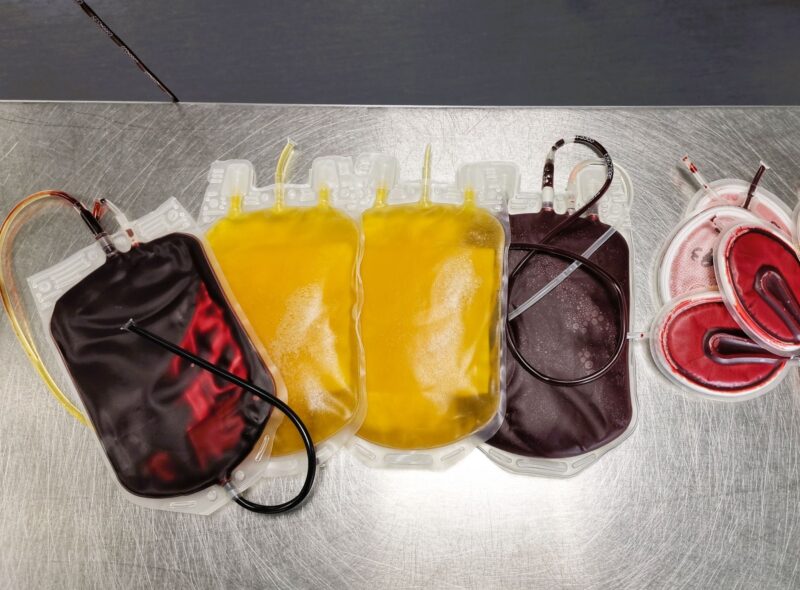
Maxime Dely: Does Whole Blood Deserve a Greater Role in Modern Transfusion Medicine?
Maxime Dely, Sales and Application Specialist in Therapeutic Apheresis and Cell Therapy, has shared a post on LinkedIn:
”𝗣𝗹𝗮𝘀𝗺𝗮, 𝗽𝗹𝗮𝘁𝗲𝗹𝗲𝘁𝘀, 𝗿𝗲𝗱 𝗯𝗹𝗼𝗼𝗱 𝗰𝗲𝗹𝗹𝘀: 𝗦𝗵𝗼𝘂𝗹𝗱 𝘄𝗲 𝗸𝗲𝗲𝗽 𝘀𝗲𝗽𝗮𝗿𝗮𝘁𝗶𝗻𝗴… 𝗼𝗿 𝘀𝘁𝗮𝗿𝘁 𝗿𝗲𝘁𝗵𝗶𝗻𝗸𝗶𝗻𝗴?
For decades, transfusion medicine has relied on a widely accepted principle: separating donated blood into components (red blood cells, plasma, platelets) to optimize each donation and target specific clinical needs.
𝘛𝘩𝘪𝘴 𝘮𝘰𝘥𝘦𝘭 𝘩𝘢𝘴 𝘴𝘢𝘷𝘦𝘥 𝘮𝘪𝘭𝘭𝘪𝘰𝘯𝘴 𝘰𝘧 𝘭𝘪𝘷𝘦𝘴 — 𝘣𝘶𝘵 𝘪𝘴 𝘪𝘵 𝘴𝘵𝘪𝘭𝘭 𝘵𝘩𝘦 𝘣𝘦𝘴𝘵 𝘢𝘱𝘱𝘳𝘰𝘢𝘤𝘩 𝘵𝘰𝘥𝘢𝘺?
In certain clinical settings — trauma, surgery, ICU — patients often receive all three components separately.
In effect, 𝘄𝗲’𝗿𝗲 𝗿𝗲𝗮𝘀𝘀𝗲𝗺𝗯𝗹𝗶𝗻𝗴 𝘄𝗵𝗼𝗹𝗲 𝗯𝗹𝗼𝗼𝗱, at the cost of logistical complexity, higher costs, and sometimes increased transfusion-related risks.
Shortages, overtransfusion, component waste, and supply chain strain are all issues pushing practitioners to reassess.
In response, 𝗺𝗶𝗹𝗶𝘁𝗮𝗿𝘆 𝗮𝗻𝗱 𝘁𝗿𝗮𝘂𝗺𝗮 𝘀𝗲𝗿𝘃𝗶𝗰𝗲𝘀 𝗮𝗿𝗲 𝗿𝗲𝗶𝗻𝘁𝗿𝗼𝗱𝘂𝗰𝗶𝗻𝗴 𝗹𝗲𝘂𝗸𝗼𝗿𝗲𝗱𝘂𝗰𝗲𝗱 𝘄𝗵𝗼𝗹𝗲 𝗯𝗹𝗼𝗼𝗱, which is simpler to store and administer, and often more physiologically effective in critical care scenarios.
At the same time, predictive tools, AI-based algorithms, and innovative products (customized components, artificial blood, freeze-dried plasma) are paving the way toward 𝗺𝗼𝗿𝗲 𝗽𝗲𝗿𝘀𝗼𝗻𝗮𝗹𝗶𝘇𝗲𝗱, 𝗲𝗳𝗳𝗶𝗰𝗶𝗲𝗻𝘁, 𝗮𝗻𝗱 𝘁𝗮𝗿𝗴𝗲𝘁𝗲𝗱 𝘁𝗿𝗮𝗻𝘀𝗳𝘂𝘀𝗶𝗼𝗻 𝘀𝘁𝗿𝗮𝘁𝗲𝗴𝗶𝗲𝘀.
So should we keep separating blood by default? Or tailor our practices to real-world needs, resource constraints, and clinical outcomes?
Rethinking doesn’t mean rejecting. It means 𝗲𝘃𝗼𝗹𝘃𝗶𝗻𝗴 𝗮 𝗵𝗶𝘀𝘁𝗼𝗿𝗶𝗰 𝗺𝗼𝗱𝗲𝗹 toward greater agility, precision, and clinical relevance.
What’s your view? Does whole blood deserve a greater role in modern transfusion medicine?”

Stay informed with Hemostasis Today.
-
Jan 5, 2026, 22:01Sifat Jubaira on Key Differences in Red Cell Indices
-
Jan 5, 2026, 20:03Alan Nurden: One of The Best Articles That I Have Read in 2025
-
Jan 5, 2026, 18:16Bartosz Hudzik on Hemocompatibility in HeartMate 3 LVAD: Progress and Persistent Challenges
-
Jan 5, 2026, 15:33Mona Ahmed on Why Some Calcified Nodules Trigger ACS and Others Do Not
-
Jan 5, 2026, 14:17Abdul Mannan – VWF:RCo for Diagnosing von Willebrand Disease: That Test Might Be Failing Your Patients
-
Jan 5, 2026, 13:57Ewang Yemi: CAD is Real and Dangerous – Keep Your Heart Beating
-
Jan 5, 2026, 13:42Dr. Martha Boeckenfeld Shares VetiGel Creation Experiment: How A 17-Year-Old Mixed Algae in a Small Hidden Lab
-
Jan 5, 2026, 12:55Chokri Ben Lamine Explains Washed PRBCs!
-
Jan 5, 2026, 12:30ASH: Be Part of The Next Cohort of Hematology Quality Improvement Leaders
